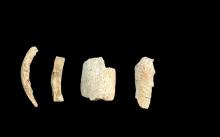Neolithic
Çatalhöyük drawing world's attention to Anatolia
Çatalhöyük's inclusion on the UNESCO World Heritage List has done wonders for tourism at the 9,000-year-old site in Central Anatolia, according to the head of the excavations at the site, Professor Ian Hodder.
"There has been an increase in the number of tourists. Çatalhöyük has become the center of archaeological tourism," he said.
- Read more about Çatalhöyük drawing world's attention to Anatolia
- Log in to post comments
New findings at Çatalhöyük
Archaeological excavations at the ancient settlement of Çatalhöyük continued in 2015, with a rare human face-like plaster head among the most exciting finds, according to excavation head Prof.
- Read more about New findings at Çatalhöyük
- Log in to post comments
T-shaped stones tell story of Göbeklitepe
As part of a Turkish-UNDP joint project, sculptors have engraved the findings of Göbeklitepe on T-shaped stones to show both the way to the site and the first steps of human civilization A path to Göbeklitepe, a 12,000-year-old site in the southeastern province of ?anl?urfa often referred as the "point zero of history," has been decorated with large stone plaques that tell about the ongoing exc
- Read more about T-shaped stones tell story of Göbeklitepe
- Log in to post comments
Morgan Freeman films in Turkish province
Famous American actor Morgan Freeman has been spotted in the Central Anatolian province of Konya while shooting part of a documentary titled "The Story of God."
The documentary, which features religious experiences and rituals from around the world, is being filmed for the National Geographic channel.
- Read more about Morgan Freeman films in Turkish province
- Log in to post comments
Lost species of Anatolia unearthed in Ephesus
Animal bones unearthed during excavations in Ephesus are being examined at a newly-established lab, giving fresh clues about people's positions in society in the ancient eraBones unearthed during archaeological excavations at the ancient city of Ephesus in Turkey's west have newly revealed that species such as leopard and rhino existed in the region.
- Read more about Lost species of Anatolia unearthed in Ephesus
- Log in to post comments
Summer archaeology workshop in Çatalhöyük
The Çatalhöyük Archaeology Workshop, organized in the Neolithic age settlement of Çatalhöyük, will take place between June 27 and July 30 this year. According to a statement by Shell Turkey, which has been supporting the archaeological activities in the ancient city since 1995, it will provide support to the research project of Standford University this year, too.
- Read more about Summer archaeology workshop in Çatalhöyük
- Log in to post comments
Skeletons embracing found in a Greek cave
A 6,000-year-old romance has been uncovered in a Greek cave as archaeologists unearthed the skeletons of an undisturbed Neolithic couple locked in an embrace, discover.com has reported.
- Read more about Skeletons embracing found in a Greek cave
- Log in to post comments
Neolithic couple buried in locked embrace at Diros (photos)
The Archaeological Service announced that a Neolithic couple, locked in embrace, was found during excavations by the northern entrance of the Alepotrypa ("Foxhole") cave in Southern Greece. The burials contained broken arrowheads accompanying the couple whose skeletons are dated to 3800 B.C. according to the C14 method. A DNA analysis confirmed that the remains were those of a male and female.
Paris hosts conference on Göbeklitepe archeological site
Leading cultural, historical and business figures came together on Jan. 21 at the UNESCO Headquarters in Paris for a conference on Göbeklitepe, during which participants reiterated their commitment to improving the Neolithic site.
Five people buried in tomb at Ancient Amphipolis, tests reveal
The remains of at least five people have been found in the Alexander the Great-era tomb at Ancient Amphipolis, the Culture Ministry said on Monday.
According to a statement, the skeletons discovered last year are that of a woman aged around 60, two men aged between 35 and 45, a child and another person whose identity has yet to be discovered because he or she was cremated.










